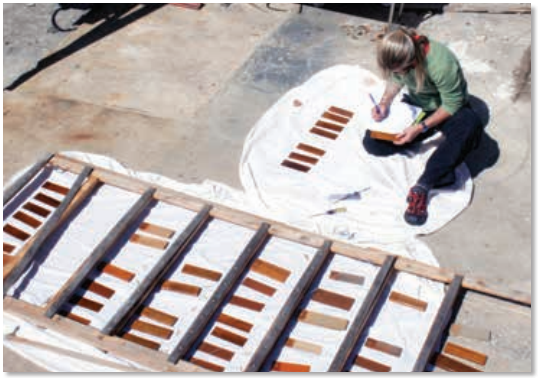Did you ever wonder why its called “wood finish?” You’re never “finished” with it. Unfortunately, that rings true for most boat maintenance tasks. With that harsh reality in mind, we set out to find the best exterior wood finish on the market, one that’s durable and easy to apply.
After multiple delays, including two brushes with tropical storms, we mounted the test rack outdoors last summer to begin the exposure test (see “How We Tested”). This report takes a look at how the test panels are faring after six months facing the elements on The Rack (pictured above), the moniker we’ve given to our test set-up.
So in our quest for the Holy Grail of wood protectors, we refrained from limiting the test to a single type of coating and are looking for a wood finish all-star. However, to make the data easier to digest, we’ve broken the test field into four categoriesone-part varnishes, two-part varnishes, synthetics and treatments, and sealers and oils. This apples-to-apples and apples-to-oranges comparison, we hope, will answer that often-asked reader query: “What wood finish should I use?”
The number of coatings on the market today is mind-boggling, hence the dozens of products in this evaluation. And, as with bottom paint, delving into formulation differences and the science behind the magic tends to only muddy the waters. So when choosing a wood finish, knowing the basic characteristics of each finish type is helpful in determining which best matches your aesthetic tastes, maintenance appetite, and protection needs.
To get the results of our testing, download Painting Your Boat, Vol. 4: Brightwork, Spar Varnish and Mast Paints today.







































This is not an article, this is an advertisement.
If Practical Sailor has decided that it will do its tests and reports, but then not provide them to subscribers unless they pay for a separate report, why I am paying for a subscription?
I have just signed up for a new subscription since I bought a boat that needs to be varnished, a major project. The last article on this subject was done in 2011. Thinking that Practical Sailor must have done several follow ups since 2011, I subscribed only to learn the only article done was a six month update, and they want me to pay for it in addition to the subscription which is supposed to give me access to ALL of your research. The varnish industry is constantly changing, Practical Sailor needs to be constantly staying on top of the changes and providing their subscribers with the information.
What is up?
I have to agree with both of these comments, publishing tests that used to be part of the base subscription in ‘pay for’ downloads is deceptive. I have been a reader and subscriber of Practical Sailor since the late 90’s when I bought my first boat. I just re-signed up (in the last few days) having purchased a 1961 Bermuda 40 that needs a restoration, a Dyer Dhow that came with it, and a Bluenose 23 from the early 70’s. The very first thing I did after subscribing was search for the latest on brightwork and figured maybe your search just wasn’t very good returning results from the early 2000’s…but I was wrong.
Mr Swayze makes a great point about the changing nature and availability of these types of products and the need for a publication like yours to be reviewing on a more regular basis.
At a minimum, there should either be a disclaimer about what is included and what’s not included with a subscription, or the option for a ‘premium’ subscription that includes everything…rather than the unpleasant surprise of thinking something as common as annual maintenance products/processes is being excluded from the subscription in favor of being an add-on.
Lastly, very disappointing that there was no reply posted here from anyone at Practical Sailor to address these legit comments after more than a year on the first, and almost 8 months on the second.